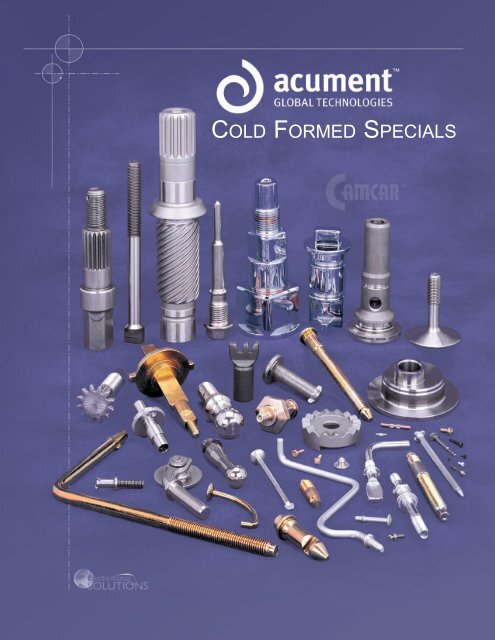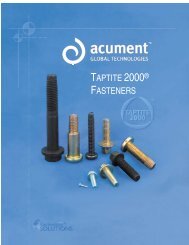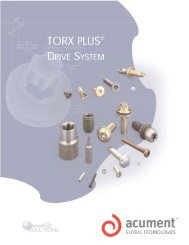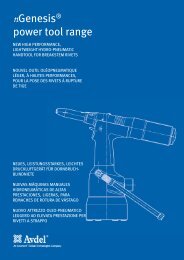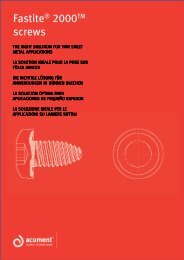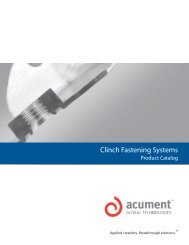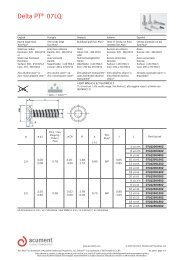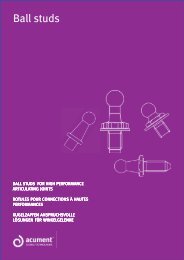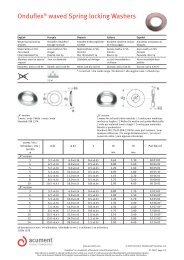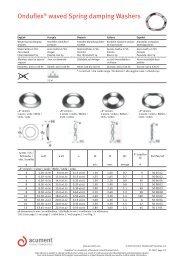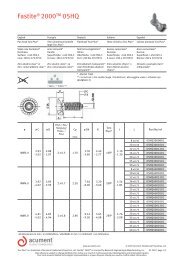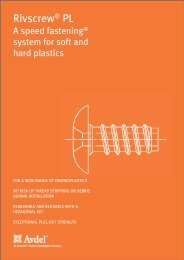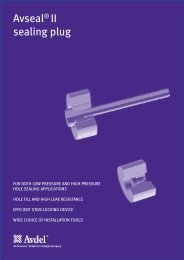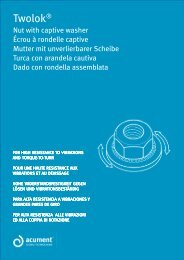Cold Form Brochure
Cold Form Brochure
Cold Form Brochure
Create successful ePaper yourself
Turn your PDF publications into a flip-book with our unique Google optimized e-Paper software.
COLD FORMED SPECIALS
U N S U R P A S S E D E X P E R T I S E<br />
Advancing technology has been the<br />
cornerstone of our success for over 50<br />
years. When Camcar developed the<br />
Raycarl ® process, it was considered<br />
the most significant breakthrough in<br />
cold forming technology in over 100<br />
years. Today, we continue to lead the<br />
industry though continuing research<br />
and investment in new technology,<br />
unsurpassed expertise and strict<br />
attention to detail. Acument Global<br />
Technologies manufactures the highquality,<br />
cost-efficient components your<br />
applications demand.<br />
QUALITY<br />
• Improved strength and reliability through<br />
work hardening and an uninterrupted<br />
grain flow<br />
• Improved surface finish over screw<br />
machined components<br />
REDUCED COSTS<br />
• Reduced scrap rates<br />
• High production rates<br />
• Ability to form parts to a net or near-net<br />
shape, which requires fewer secondary<br />
operations to achieve finished form<br />
• Allows multi-piece assemblies to be<br />
manufactured as a single component<br />
• <strong>Cold</strong> forming often uses significantly less<br />
raw material for the same component<br />
<strong>Cold</strong> forming, or cold heading, forms<br />
shapes without causing scrap material.<br />
Since raw material can be the most<br />
expensive aspect of a part, cold<br />
forming is often a lower cost alternative<br />
to screw machining and other<br />
manufacturing methods. Expanding<br />
cold forming technology is allowing<br />
increasingly complex components to<br />
be manufactured at very high<br />
DESIGN FLEXIBILITY<br />
• Unique and diverse shapes, including<br />
parts with multiple diameters, extrusions,<br />
blind holes and through holes<br />
• Eccentric or asymmetrical bodies<br />
possible<br />
• Large head to shank ratios without<br />
secondary machining
C O L D F O R M I N G P R O C E S S E S & C A P A B I L I T I E S<br />
Dies and Punches<br />
Cut-off<br />
1st Blow<br />
One Die, Two-Blow Process<br />
extrusion<br />
punch<br />
die<br />
<strong>Cold</strong> forming uses forces greater than a metal‘s elastic limit<br />
to form shapes without causing scrap material.<br />
First the material, in wire form, is drawn into the header,<br />
and is cut off at the desired length. Next, a series of<br />
engineered dies and punches are used to form shapes by<br />
upsetting or extruding the cut-off.<br />
ONE DIE, TWO-BLOW PROCESS<br />
The two-blow cold forming process allows upsets and<br />
extrusions to be achieved on the same component. The<br />
first blow provides the rough shape, while the second blow<br />
forms the final shape.<br />
ADVANCING TECHNOLOGY<br />
The Raycarl ® process was developed by Camcar to<br />
manufacture shapes which exceed the upset or extrusion<br />
limits of conventional one- and two-blow cold forming.<br />
Cut-off 1st Blow 2nd Blow<br />
Two Die, Three-Blow Process<br />
Today, cold forming technology has advanced far beyond<br />
this innovative process.<br />
TWO DIE, THREE-BLOW PROCESS<br />
With its additional impact/extrusion die, the two<br />
die, three-blow process can provide up to<br />
4-1/2 diameters of upset, larger head ratios<br />
and more diverse shapes than a one die<br />
process.<br />
Multi-die forming, which uses several<br />
impact/extrusion dies on one header, allows<br />
even greater capabilities (see following page).<br />
Cut-off 1st Blow 2nd Blow<br />
3rd Blow<br />
UPSETS<br />
Upsetting allows heads or shapes<br />
larger than the wire diameter to be<br />
formed by exerting force on one end of<br />
the blank. The<br />
portion of<br />
the blank<br />
to be upset<br />
is<br />
measured<br />
by wire<br />
diameters<br />
of upset.<br />
EXTRUSIONS<br />
Extruding is done by two methods: forward and<br />
backward. With forward extrusions, the metal blank is<br />
forced into a die opening smaller<br />
than the wire diameter, achieving a<br />
decrease in blank diameter and an<br />
increase in length. With backward<br />
extrusions, a punch smaller in<br />
diameter than the blank<br />
is forced into the blank,<br />
causing the material to flow<br />
backward around the punch,<br />
forming cylindrical holes.<br />
3
C O L D F O R M I N G P R O C E S S E S & C A P A B I L I T I E S<br />
MULTIPLE-DIE FORMING<br />
Through multiple-die forming, the final shape is<br />
achieved in stages. Multiple-die headers have<br />
more dies and punches on each machine<br />
to allow for:<br />
• increased areas of reduction<br />
• forming unique shapes such as multiple<br />
diameters on one component<br />
• large head to shank ratios<br />
• possible elimination of secondary operations<br />
such as drilling, turning and trimming<br />
Current technology includes off line set-up,<br />
computer-controlled tool loading, and trimming<br />
capabilities within the header.<br />
Cut-off 1st Die, 1st Blow 2nd Die, 2nd Blow<br />
MULTIPLE DIE PROGRESSION<br />
Through multiple-die forming, the final shape is<br />
achieved in stages. The six stage process<br />
shown here, from cut-off to<br />
finished blank, often takes<br />
less than 1/2 second.<br />
Progression Dimensions<br />
Cut-off (Stage 1): Length – 62.55mm (2.46")<br />
Diameter – 18.28mm (0.72")<br />
Finished Blank (Stage 6): Length – 98.06mm (3.86")<br />
Smallest Diameter – 9.488mm (0.374")<br />
Largest Diameter – 46.91mm (1.85")<br />
3rd Die, 3rd Blow 4th Die, 4th Blow 5th Die, 5th Blow<br />
MULTIPLE-DIE HEADERS<br />
Acument Global Technologies<br />
has a wide range of multiple-die<br />
headers and other equipment to<br />
manufacture components to your<br />
specific requirements.<br />
• Cut-off diameters up to<br />
1.6" (31mm)<br />
• 50 to 200 pieces per minute<br />
• Reduced set-up time<br />
• Highly conducive to<br />
short runs<br />
• Offers tight part<br />
tolerances to eliminate<br />
many secondary<br />
operations<br />
4
CANDIDATES FOR<br />
COLD FORMING<br />
Any one of the following criteria make a part a<br />
strong candidate for cold forming:<br />
• Large head to shank ratio<br />
• Part is longer than 1-1/2 times its<br />
largest diameter<br />
• Part has multiple diameters<br />
• High production<br />
quantities needed<br />
• Raw material is a<br />
large portion of part‘s<br />
total cost<br />
• Part has fine surface<br />
finish requirements<br />
• Strength, hardness<br />
and ductility must<br />
meet certain<br />
requirements<br />
• Part requires a<br />
geometrical shape, a<br />
drive system or an<br />
extrusion<br />
Round or concentric extrusions,<br />
for shafts or threading; multiple<br />
diameters are possible<br />
External shapes, such as splines,<br />
squares, flats and drive systems<br />
Eccentric or asymmetrical bodies<br />
that are within the initial wire<br />
diameter<br />
SIZE RANGES<br />
Diameters: 1.27mm to 41mm (.020" to 1.6")<br />
Lengths:<br />
• 355mm (14") under the head with<br />
diameters to 38mm (1.5")<br />
• 432mm (17") under the head with<br />
diameters to 22mm (.875")<br />
Actual sizes are dependent on the complexity of the<br />
component. Please contact a Acument Global<br />
Technologies applications engineer for more information.<br />
Blind or through holes, which<br />
eliminate secondary drilling<br />
operations<br />
5
C O L D F O R M E D E Q U I P M E N T & C A P A B I L I T I E S<br />
MATERIALS<br />
Through continual development and modification<br />
of manufacturing techniques, Acument Global<br />
Technologies can cold form many unusual<br />
materials. This allows easy conversion from screw<br />
machining and other manufacturing methods.<br />
Material<br />
Low Carbon Steel<br />
1005 1008<br />
1010 1018<br />
1022<br />
Medium Carbon Steel<br />
1030 1035<br />
1038 1040<br />
1045 1050<br />
Alloy Steel<br />
1541 4037<br />
4130 4140<br />
4340 8620<br />
8640 8740<br />
Tool Steel<br />
52100 M2<br />
Copper<br />
CDA102 ETP110<br />
Brass<br />
CDA220 CDA230<br />
CDA260 CDA270<br />
Bronze<br />
Silicon Commercial<br />
Aluminum<br />
2017 2024<br />
6061 5056<br />
Stainless Steel<br />
302HQ 316L<br />
321 405<br />
410 420<br />
430F 431<br />
17-4PH Camtronic ®<br />
A286<br />
Characteristics<br />
offers relative ease of<br />
formability; relative low cost<br />
as compared to other<br />
materials<br />
for high strength applications;<br />
good formability; heat<br />
treatable<br />
for high strength applications<br />
(Class 10.9/Grade 8 and<br />
above); offers highest<br />
hardenability and toughness;<br />
heat treatable<br />
for high strength applications;<br />
good wear resistance<br />
for corrosion resistance; good<br />
formability; offer excellent<br />
soldering, welding and<br />
brazing properties<br />
for corrosion resistance;<br />
lightweight; excellent<br />
formability<br />
for superior corrosion<br />
resistance; allows for work<br />
hardening from cold forming,<br />
which is especially important<br />
for non-heat-treatable grades;<br />
good heat resistance; some<br />
offer desired magnetic or<br />
non-magnetic properties<br />
HEAT TREAT<br />
Several types of heat treatment are available<br />
to meet desired hardness, strength, and<br />
ductility characteristics, including:<br />
• Through hardening: entire part is hardened<br />
and tempered to desired strength level<br />
• Case hardening: surface hardness is raised<br />
to a level higher than the core hardness and<br />
the material the component will be in contact<br />
with (not recommended for structural<br />
applications)<br />
• Annealing: softens part that is work<br />
hardened to enhance certain secondary<br />
processing or meet functional application<br />
requirements<br />
• Selective hardening/selective induction<br />
hardening: only a portion of a component is<br />
hardened<br />
• Carbonitriding: carbon and nitrogen content<br />
of the surface is raised to a level higher than<br />
the core for improved surface hardness<br />
PLATINGS<br />
In selecting plating, several aspects must be<br />
considered, including desired corrosion<br />
resistance, lubricity and appearance, as well<br />
as concerns over cost and toxicity. Acument<br />
Global Technologies has a wide array of<br />
platings available to meet the specific needs of<br />
your application.<br />
Please contact a Acument Global<br />
Technologies application engineer for more<br />
information on what type of heat treatment and<br />
plating is appropriate for your application.<br />
Other materials may be available. Please contact<br />
an Acument Global Technologies applications<br />
engineer for assistance.<br />
6
C O L D F O R M I N G E Q U I P M E N T & C A P A B I L I T I E S<br />
SECONDARY OPERATIONS<br />
<strong>Cold</strong> forming allows products to be<br />
manufactured to net or near net shape.<br />
Acument Global Technologies also offers a<br />
full line of precision secondary operations to<br />
meet more specific requirements.<br />
CAPABILITIES INCLUDE:<br />
• Roll forming<br />
• Finishing<br />
• Roll threading • Burnishing<br />
• Tapping<br />
• Assembly<br />
• Broaching<br />
• Trimming<br />
• Grinding<br />
• Drilling<br />
• Turning/Shaving • Milling<br />
• Slotting/Sawing • Flattening<br />
• Reheading<br />
• Knurling<br />
PRECISION MACHINING<br />
Acument Global Technologies has a wide array<br />
of equipment that allows multiple secondary<br />
operations with extremely tight tolerances to be<br />
performed. A single machine can perform up to 12<br />
operations per part, including turning, grooving<br />
and drilling.<br />
Utilizing this precision equipment can be less<br />
expensive than other secondary machining<br />
methods because several operations can be done<br />
on one machine at very high speeds. These<br />
machines also offer continuously high quality,<br />
holding diameter tolerances to .025mm (.001")<br />
and length tolerances to .127mm (.005").<br />
Roll<br />
Threading<br />
Grinding<br />
Trimming<br />
Drilling &<br />
Tapping<br />
Turning/Shaving<br />
Knurling<br />
Broaching<br />
Reheading<br />
Burnishing<br />
7
F R O M S C R E W M A C H I N I N G T O C O L D F O R M I N G<br />
Our wide array of cold forming processes<br />
allow even the most complex screw<br />
machined components to be converted to<br />
cold formed components. There are many<br />
reasons to switch:<br />
<strong>Cold</strong> forming provides stronger and more<br />
reliable parts. The cold forming process<br />
causes the raw material to work harden as<br />
it conforms to the desired shape, providing<br />
an uninterrupted grain flow that follows the<br />
contour of the part.<br />
• provides improved yield and ultimate<br />
tensile strength<br />
• provides greater fatigue strength,<br />
especially at critically-stressed corners<br />
Although these characteristics can eliminate<br />
the need for heat treating, the hardness of cold<br />
formed components can be enhanced with<br />
these treatments, with the added benefits of<br />
improved ductility and fatigue strength.<br />
<strong>Cold</strong> forming components provide better<br />
wear resistance. <strong>Cold</strong> forming produces a<br />
surface finish of 63 micro inches, which is<br />
superior to the finish typically produced on<br />
machined surfaces. If a smoother surface<br />
is required, Acument Global<br />
Technologies can utilize secondary<br />
operations to achieve a finish as low as 6<br />
micro inches.<br />
• provides a higher wear resistance<br />
• since machining is eliminated or kept to<br />
a minimum, the possibility of machining<br />
notches, which can cause premature<br />
failure, is also reduced<br />
The section of a screw machined component<br />
(above) demonstrates how the grain of the material<br />
is interrupted by this process. The section of a<br />
cold formed component (below) demonstrates<br />
how the material flows around critical corners,<br />
increasing strength.<br />
<strong>Cold</strong> forming provides higher production<br />
rates. Multi-die cold form headers can<br />
produce up to 200 parts per minute,<br />
because they progressively form multiple<br />
parts with each machine cycle. Screw<br />
machining, whether single or multiple<br />
spindle, typically averages less than 50<br />
pieces per minute.<br />
<strong>Cold</strong> forming can reduce scrap by 80%<br />
and more. Screw machining only removes<br />
material, so it requires bar stock to be as<br />
large as the largest diameter of the<br />
8
F R O M S C R E W M A C H I N I N G T O C O L D F O R M I N G<br />
finished component,<br />
resulting in excessive<br />
scrap.<br />
<strong>Cold</strong> forming moves<br />
material, so the original<br />
wire stock can be<br />
significantly smaller.<br />
• requires less material<br />
• generates minimal scrap<br />
• minimizes scrap<br />
handling and removal<br />
costs<br />
This is especially<br />
important with expensive<br />
raw materials.<br />
The cold formed cut-off (right) is often significantly smaller than the<br />
screw machined blank (left) required to form the same part (shown in the middle).<br />
<strong>Cold</strong> formed cut-off: 326 lbs./1000 pcs.<br />
Screw machined blank: 3,000 lbs/1000 pcs.<br />
Raw material savings: 2,674 lbs/1000 pcs.<br />
FROM ASSEMBLIES TO SINGLE-PIECE PARTS<br />
Assemblies consisting of two or more components can be cold<br />
formed into strong, reliable single-piece parts. This can lower<br />
costs in a number of areas through:<br />
• elimination of assembly or welding operations<br />
• increased production rates<br />
• minimized part handling<br />
• parts consolidation and reduced inventory management<br />
This single<br />
component, a<br />
shaft for a drive<br />
fork, was once a<br />
3-piece assembly.<br />
<br />
This component, used on a wheelchair lift, was originally a<br />
screw machined shaft welded to a washer. Today, the shaft<br />
and washer are cold formed as a single unit, with an<br />
uninterrupted grain flow. Secondary operations are<br />
used for drilling and tapping the shaft and<br />
broaching the flats. Even with these secondary<br />
operations, the resulting part is stronger<br />
and less expensive than the original<br />
assembly.<br />
9
S U C C E S S W I T H C O L D F O R M E D C O M P O N E N T S<br />
MATERIAL CAPABILITIES FULFILL REQUIREMENTS<br />
Application: Airbag mount assembly<br />
Component: Attachment pin<br />
Original process considered: Die-casting<br />
Needs/Problems: During prototyping, it was determined that the die-cast<br />
material could not meet the mechanical performance requirements of the<br />
application.<br />
Acument Global Technologies SOLUTION: <strong>Cold</strong> forming 10B21 material, followed by secondary<br />
machining<br />
Customer Benefits:<br />
• Provides a strong, reliable component<br />
REDUCED MATERIAL COSTS<br />
Application: Automotive brake assembly<br />
Component: Piston rod<br />
Original process used: Screw machining<br />
Needs/Problems: Screw machining required use of bar stock of the<br />
largest diameter<br />
Acument Global Technologies SOLUTION: <strong>Cold</strong> forming followed by a<br />
shave operation<br />
Customer Benefits:<br />
• Material cost savings of $0.60 to 0.80 per component<br />
DECREASED COSTS AND INCREASED STRENGTH WITH COLD FORMING<br />
Application: Door lock<br />
Component: Dead bolt<br />
Original process used: Powdered metal forming<br />
Needs/Problems: Powdered metal components had high costs and could not meet<br />
durability requirements<br />
Acument Global Technologies SOLUTION: Both external and internal shapes were<br />
completely cold formed, including blind hole; no secondary operations were<br />
necessary<br />
Customer Benefits:<br />
• High strength, durable components<br />
• Lower costs<br />
STRONGER PARTS THROUGH COLD FORMING<br />
Application: Steering system<br />
Component: Shaft with involute spline<br />
Original process used: Screw machining<br />
Needs/Problems: Machined splines did not meet strength<br />
requirements<br />
Acument Global Technologies SOLUTION: <strong>Cold</strong> formed 1035 alloy<br />
shaft and rolled threads; involute spline created in second cold-forming<br />
operation to minimize damage. Secondary operations included grinding of<br />
round diameters and cross-drill.<br />
Customer Benefits:<br />
• Stronger, more reliable part<br />
• Reduced overall costs<br />
10
S U C C E S S W I T H C O L D F O R M E D C O M P O N E N T S<br />
INTERNAL ROLLED THREADS PROVIDE HIGH PRECISION FIT<br />
Application: Motorcycle wheel assembly<br />
Component: Internally-threaded fastener for attachment of wheel spokes to tire<br />
rim<br />
Original process used: <strong>Cold</strong> formed part with cut-tapped hole<br />
Needs/Problems: Cut-tapped hole could not meet automation requirements<br />
Acument Global Technologies SOLUTION: <strong>Cold</strong> formed blank with squared<br />
end, TORX PLUS ® Drive recess, and hole. Internal threads were rolled<br />
instead of cut.<br />
Customer Benefits:<br />
• Increased thread quality<br />
• Decreased assembly line rework due to threading issues<br />
SPECIAL THREAD REQUIREMENTS MET EASILY<br />
Application: Automotive engine assembly<br />
Component: Pipe plug housing requiring smooth threads to<br />
accept O-ring assembly; also, bottom of cup must be flat to .05"<br />
and first step in cup must be smooth<br />
Original process considered: Screw machining<br />
Needs/Problems: Required tapered threads, which can not be screw<br />
machined<br />
Acument Global Technologies SOLUTION: <strong>Cold</strong> formed<br />
component with rolled threads. Secondary operation used to<br />
meet tight tolerance requirements on inside diameters.<br />
Customer Benefits:<br />
• Material savings<br />
• Tapered threads and tight tolerances met<br />
FROM TWO-PIECE ASSEMBLY INTO A SINGLE COMPONENT<br />
Application: Commercial air conditioner<br />
Component: Valve stem<br />
Original process used: Two-piece screw machined, 302 stainless steel parts<br />
brazed together<br />
Needs/Problems: Two-piece part was not meeting<br />
strength requirements of application<br />
Acument Global Technologies SOLUTION: 3/8" x 3"<br />
one-piece cold formed 302 stainless steel part with<br />
TORX ® recess and squared end. CNC turning, burnishing<br />
and grinding were used to achieve 32 micro inch finish and<br />
desired concentricity.<br />
Customer Benefits:<br />
• Stronger parts<br />
• Elimination of brazing process<br />
• Lower material and product costs<br />
11
VALUE ADDED SERVICES TO MEET YOUR NEEDS<br />
Quality Assurance • All of our<br />
manufacturing facilities are<br />
ISO 9000 and/or QS-9000<br />
registered. We are always<br />
working to meet the most<br />
current standards available.<br />
Integration of Statistical<br />
Process Control (SPC)<br />
procedures and our A2LA<br />
Calibration lab further ensure<br />
that our components meet<br />
your assembly requirements.<br />
Metallurgical Laboratory • Our<br />
A2LA-accredited lab provides<br />
raw material evaluation,<br />
chemical analysis and failure<br />
analysis in order to identify<br />
and resolve potential<br />
problems.<br />
Fastener Engineering and<br />
Testing Laboratory • Our<br />
state-of-the-art testing facility<br />
can analyze everything from<br />
your fasteners to your entire<br />
assembly. Portable<br />
equipment is available for use<br />
on your assembly line.<br />
Global Supply • As a multinational<br />
group of engineering,<br />
sales and manufacturing<br />
companies, we can provide<br />
fastening solutions on a<br />
global scale, including cold<br />
formed components,<br />
engineered threaded<br />
fasteners, blind fastening<br />
systems, stamped metal<br />
components, molded plastic<br />
components and engineered<br />
assemblies.<br />
12<br />
Design and Applications<br />
Assistance • Simultaneous<br />
engineering, analysis and<br />
hands-on testing are used to<br />
examine materials, assembly<br />
conditions and joint design,<br />
in order to identify your<br />
optimal fastening solution<br />
and increase the reliability of<br />
your product.<br />
For more information, please contact:<br />
6125 Eighteen Mile Road<br />
Sterling Heights, Michigan 48314<br />
1-800-544-6117<br />
acument.com<br />
camcarsolutions.com<br />
ringscrew.com<br />
Supply Chain Management<br />
Services • Vendor-managed<br />
inventory programs, JIT<br />
programs, global warehousing<br />
and more is available to help<br />
you manage your assembly<br />
line.<br />
Raycarl ® , Camcar ® , Camtronic ® , TORX PLUS ® and TORX ® are registered trademarks of Acument Intellectual Properties, LLC.<br />
Printed in the U.S.A. ©2002-2007 Acument Intellectual Properties. REV: 02/01/07


